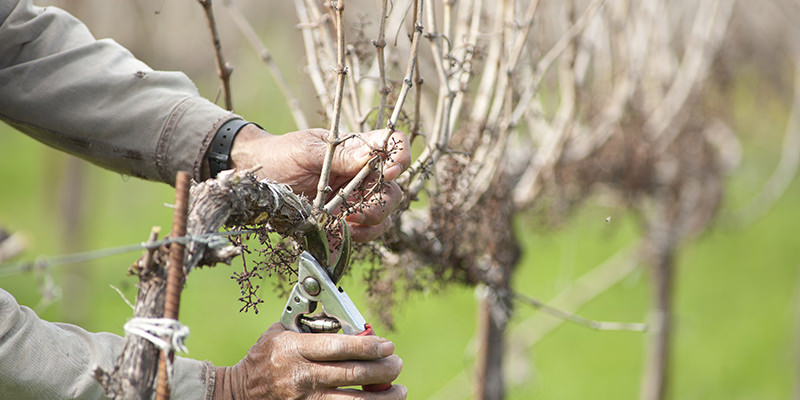Despite blizzards in the Northwest, tornadoes in Texas, or Trump-dominated newscasts everywhere, it’s spring in California. Translation: the race is on against Mother Nature to prune and prep 928,000 acres of vineyards for the 2016 season.
But what exactly does “pruning” entail? Tired of reading confusing articles on canes, cordons, and spurs, I convinced a friend to give me a clippers-in-hand tutorial on spring’s most time-consuming vineyard process. The result was discovering that pruning is far more than superficial landscaping, and neatly manicured vines are a convenient byproduct of job that literally (and painfully) makes a successful vintage possible.
The purpose of pruning is simple: to control and direct a vine’s growth for the upcoming season. Like setting a destination via GPS, pruning charts the course of a vine’s annual expansion and eventual grape yield. Anytime yields are involved, money is involved too, and that makes pruning extremely important.
Don't Miss A Drop
Get the latest in beer, wine, and cocktail culture sent straight to your inbox.Restricting a vine’s growth might sound frivolous – growers want maximum grapes, right? – until you discover that grapevines are insanely vigorous. Without careful pruning – by which I mean aggressive hacking – vines quickly descend from manicured, productive cash crops to wild, tangled bushes. Messy bushes yield far fewer grapes than their picture perfect counterparts, making timely and efficient pruning critical.
Pruning strategies vary based on a wide variety climatic conditions including sun exposure, dominant winds, grape variety, and the likelihood of bud-killing frosts. Growers first take these factors into account, and then select an optimum number of “growth points” for each vine. These are the places where new, green shoots will grow from the hard, tree-like wood of the vine to produce leaves and grapes for the upcoming year. On each growth point, growers leave two small, fuzzy buds – like a tiny pussy willow branch – and hack off the rest of the vine’s dormant shoots with common garden clippers in most cases.
Throughout the process, workers aim to preserve the vine’s strongest limbs, which usually have the longest, most bud-covered shoots. By removing the smaller, weaker branches, workers encourage each vine to focus on a few successful areas, and prevent it from expanding in all directions. Like a motivational pep talk from a best friend, pruners help a vine focus on its successful areas, and literally remove distracting small branches.
Though winegrowers aren’t pruning vines into ornate shrub sculptures, that doesn’t make it an easy job, and I’ve got the blisters to prove it.
In the head-trained Zinfandel vineyard of my pruning debut, eight growth points were left on each tree-shaped vine. One by one, we unceremoniously chopped off the long, spindly shoots left over from 2015 –sometimes removing fifty or more buds from up to 15 shoots. As the branches piled up between the rows, it was hard not to feel like a vine Goddess, deciding exactly which grapes got the chance to flourish in 2016.
After two long rows, the magic faded as pruning reality came into focus.
My first, sad discovery was that pruning is time consuming. Despite my speediest efforts, each row took nearly an hour of slashing and branch-pulling to complete. What at first seemed like a meditative process now seemed torturous, and there were a mere 250 vines left to trim. In large vineyards, it takes anywhere from 15-20 hours to prune a single acre encompassing thousands of vines, according to viticulturalist Ann Kraemer, who tends 40 rolling acres in California’s Amador County. As a result, pruning often lasts weeks in large commercial vineyards, even with teams of experienced workers and fancy equipment.
Not only can the task of pruning seem infinite, but it requires attention to detail throughout. A quick daydream, and a few accidental snips ruin the carefully calculated number of buds and growth points, transforming deliberately planned pruning into a dubious, “Well, I hope this works?” scenario. Like giving Barbie a haircut, even the best intentioned pruner can seriously damage a vine in just a few minutes.
Finally, blisters suck. Despite gardening gloves, my hands were in serious pain by the end of the pruning spree, and sore the next day too. This job takes skill and practice, and no, having a home or fire escape garden doesn’t count.
As I joyfully exited that vineyard, meditating on the merits of a desk job, the backbreaking skill behind pruning, and my immediate need for hard alcohol, my Nirvana moment arrived: Pruning and other intensive tasks are the reason most growers aren’t also winemakers — there just isn’t enough time in the year for all that. At heart, pruning may simply be cutting vines down to size, but in practice it takes skill and the preparation matters as much (or more) than a season’s weather conditions or a winemaker’s expertise.

